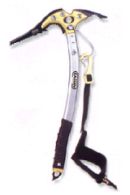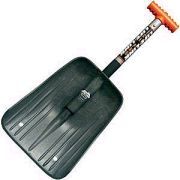|
emergency survival kit for skiers
Emergency survival kit ought to be considered for those beyond the boundry snow expeditions to areas of vast terrain, where the closest ski patrol is well out of sight. This survival product will be your closest friend when travelling abroad. Having mentioned this I suggest you never venture out on your own.
If you are challenged by the odd ski expedition, stretching your comfort zone, nothing beats advice handed down from those that have been conquering the mountains before our advancements of; modern clothing, ski gear, and communication technologies.
What is of great convenience is that the emergency survival kit described below can be assembled into a small back pack, making it your ski companion and your life saver.
Ice Axe mainly if you travel over glacierized regions, or
rugged, iced, mountain terrain. Light weight axes are favoured by ski patrols or trekkers, and are generally shorter in length, have a moderate hooking angle( angle between the handle and the hook). The shaft and the pick angle is usually 65-70deg. This angle is a good balance between, sharper angled axes more suitable for . digging into ice, and less acutely angled ones, more suitable for softer snow.
Snow Shovels -consider broad scoop finished ones, which are more efficient at shifting snow. This feature helps if you’re building a cavern, an igloo or when stranded on the wrong side of the mountain, or camping overnight ,or better still trying to uncover an avalanche victim. A neat
attribute is- alloy or fibreglass construction as it is very light weight to carry. Foldable versions are easy to fit into a small pack.
Hydration Packs or back pack style hydration systems, are small packs, contoured to follow the spine. Some resemble a dog bone.The vertically insertable water bladder works well in 1.5-3L variety. The most important is a large bladder opening for the ease of cleaning after use. Recently added chemical anti-bacterial treatments to the bladder are also a benefit. Vertically stacked kangaroo pouches are handy if you are running out of pockets in your jacket.
Neat for extended snow trips.
Emergency rescue beacons They operate at 457khz .Most are cup sized, have a life span of 48hrs when activated, and last up to 10 years. Preferably wear one strapped to your body, under the jacket, rather than in the back pack.If you are under an avalanche or in a crevasse this is your only link with the outside world. Packs can be lost when tumbling down the mountain especially when not properly strapped to your body. This should be your bare minimum of the emergency survival kit.
Global Positioning System based beacons are a little more sophisticated, operate at 406mhz precise satellite tracking can locate you to within 100metres or 330feet. Low orbital satellites can find you anywhere in the world.
Back Packs - go for water proof fabrics. Decide on the capacity of the pack , usually expressed in cubic inches or litres. For trans-continental travellers I recommend 80 litre or 50000 cubic inches.
Whistle can be very usefull when calling for help, especially when exhausted and the howling winds try to muffle you.
Flashlight or head mounted lamp- most places in the northern hemisphere experience winter sunset around 4 pm. Some of the deep valley resorts get sunset at 3.30pm. Consider Lithium operated batteries as this is the only type where the voltage remains constant throughout different temperatures. Its as efficient at minus 18deg Celsius(zero Ferenheit)as at room temperature.
Avalanche Probe-this is an extendable pole, somewhat like an antenna, which can be planted at your distress site. A lot of them are made of autofluorescent plastic, some have reflectors mounted. This helps the rescue party with locating you.
First Aid kit -preassembled versions are readily available through mountaineering shops. They mostly carry band aids, swabs, elastic matts, bandages, sterile gauze and eye straps and if your friend is a para-medico or a medico, anti-inflammatories such as Ibuprofin or much stronger Decamethasone and diuretics such as Acetazolamide or Diamox.
Repair Kit –Swiss knife, sticky tape, wire, few binding screws -primarily there for bindings repair.
Food Pack – have energy bars, dried fruit and meats, nuts, or pressure sealed food which will not decompose.
Mobile Phones are of some help, if you can get coverage where you are skiing. The technological developments in this area are merging and evolving so quickly perhaps this will become the replacement to the beacon in the not so distant future.
Maps and compasses useful particularily if you are on extended trips. Be mindful of the limitations of the compass depending on geological mountain composition around you. The true north could be elsewhere.
Survivor of an avalanche in New Zeland September 2005 Whilst traversing the Arrowsmith Range a party of four was hit by an unexpected avalanche. One of the survivors was swept for few hundred metres, describing the event as swimming trapped in white water rapids.
So fellow skiers entertain the idea of the emergency survival kit we offer you, I feel it is a piece of mind, which may save your life.
EMERGENCY FIRST AID KIT
GPS/BEACON EMERGENCY PRODUCT
GPS/BEACON
|






